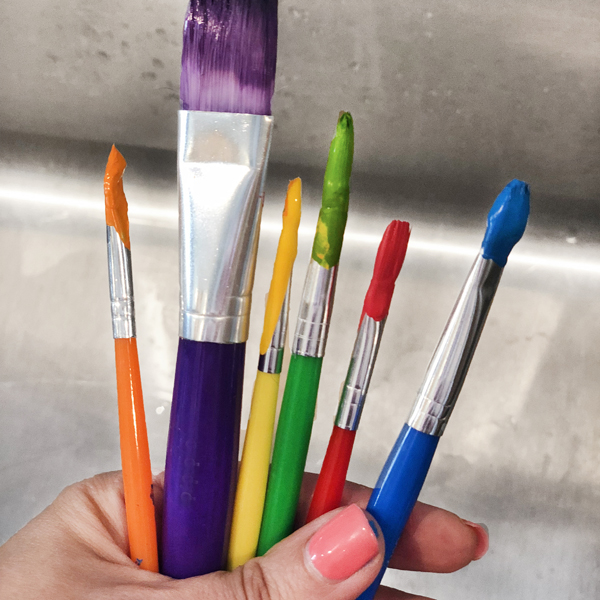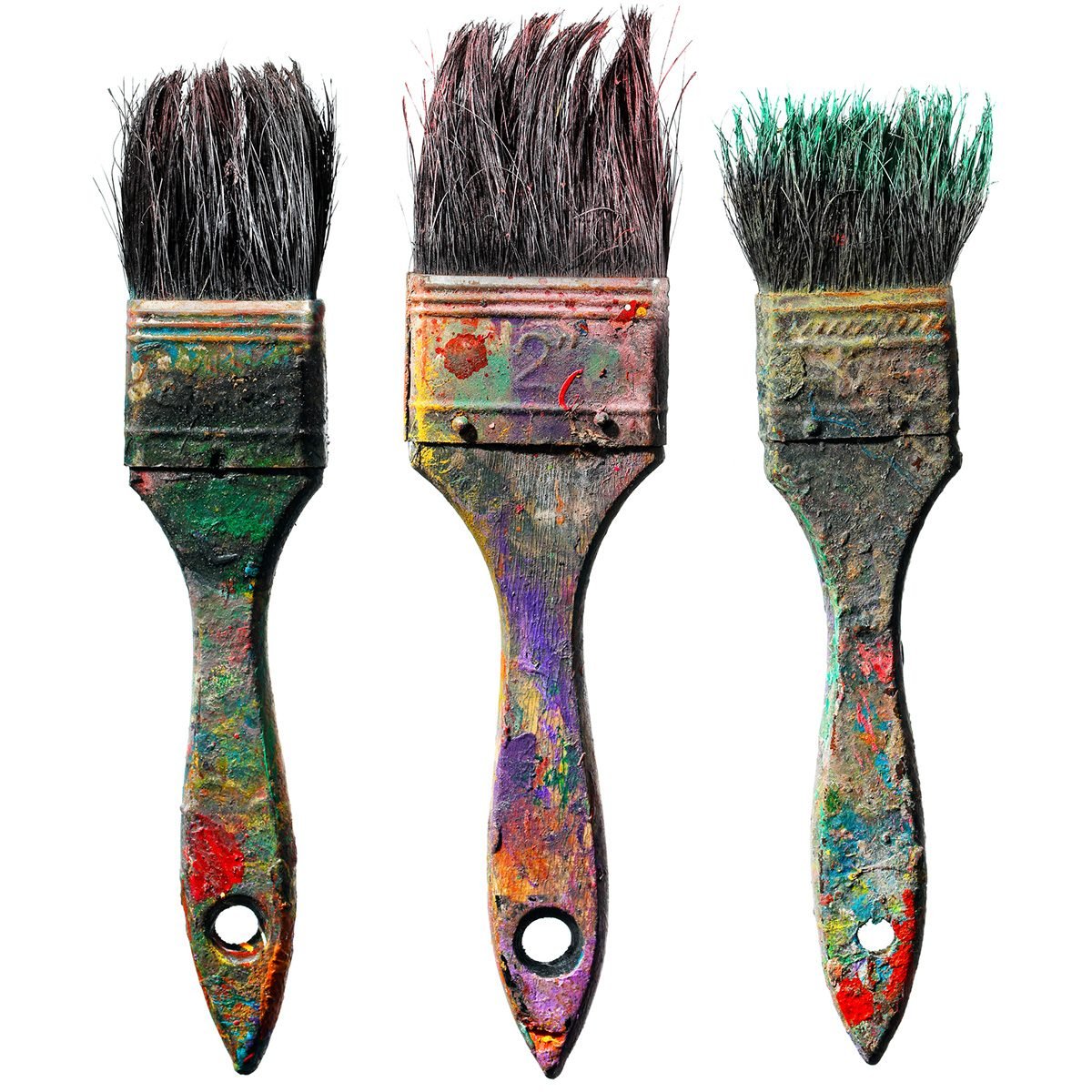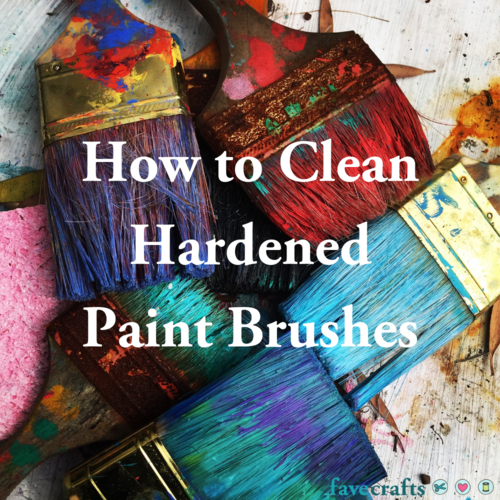Once clean, use the paint brush comb to straighten the bristles or filaments to prevent 'fingering.' Reshape the paint brush to its original shape, replace in its keeper and lay flat to dry. (After hard use, it may be necessary to steam synthetic paint brushes or dip natural bristle paint brushes in boiling water to aid in reshaping.).
- Cleaning Hardened Paint Brushes
- Clean Dried Paint Brushes Acrylic
- Cleaning Hardened Latex Paint Brushes
- Cleaning Dried Paint Brushes Latex
- Cleaning Paint-Hardened Brushes It can be a challenge to remove old, dried paint from brushes, but often the effort is worth it. Effectively washing a “petrified brush” can.
- General Pencil Company's Master Brush Cleaner and Preserver (Buy from Amazon) cleans and restores brushes even after acrylic paint has dried and hardened in them. It cleans brushes used with oils, acrylics, watercolors, and gouache.
Follow these simple steps to properly clean paint brushes after your next do-it-yourself project.

Photo: istockphoto.com
An investment in high-quality paint brushes is wasted if they are not properly cleaned and stored after use. Indeed, rushing through the end of a paint job can leave you with flecks of paint in your brushes—which will lead to an imperfect finish on your next project—as well as misshapen bristles. So invest the extra two minutes it takes to do the job right and follow this guide on how to clean paint brushes.
MATERIALS AND TOOLS Available on Amazon
– Newspapers
– Mineral spirits
– Turpentine
– Mild liquid dish soap
– Small plastic buckets
– Paint brush and roller spinner
– Rags
The Right Way to Clean Paint Brushes

Photo: istockphoto.com
- Use up what paint remains on your brush on whatever you are painting.
Press the bristles against the inside of the paint can, and lift it up and out as you do—that will squeeze out more paint. Paint away the rest on newspapers, because cleaning a brush is made easier if you remove as much of the paint from its bristles as possible. - Next, examine the can of paint, and use the appropriate solvent.
The right solvent makes the job easy by loosening dried paint, but the wrong one will probably be no help at all. Fill a small bucket with one of the following depending on the type of paint you’ve used:- Mineral spirits or turpentine to remove oil-based paint
- Hot water and mild liquid dish soap to clean paint brushes that have been used to apply latex paint
- Immerse the paint brush in the solvent.
Stir the solvent with the brush for about 10 seconds, wiping and squeezing the bristles on the sides of the container. Work the bristles between your fingers, and run a brush comb through them to remove excess paint without damaging the bristles. If some of the paint has begun to dry on the brush, soaking the brush may be necessary. - Wash it in warm soapy water in a utility sink or bucket.
Once the paint has been removed from the brush, warm soapy water will clean the brush of the solvent and remaining paint. - Shake or spin the paintbrushes dry.
Before you store your paint brushes, you’ll want to remove all of the water from their bristles. Many DIYers will do so by shaking the brush at the top of a bucket and then blotting the brush dry with a clean rag or newspaper.But, for those that have plans to do a lot of painting and wish to preserve their tools, a brush and roller spinner will come in handy. This dual-purpose tool will speed-dry either type of paint applicators using centrifugal force. Just attach a paint brush to the bottom of the tool, then pump the top several times to spin it and fling all water off the business end of the brush.
- When storing paint brushes, hang them up or lay them flat.
Hanging paint tools from a pegboard in your workshop or craft room is not only a great organizational method, but it ensures that the brush’s bristles don’t get bent out of shape stuffed in a bin somewhere. Replace the packaging on your paint brush to maintain its form and prolong its useful lifespan.

Photo: istockphoto.com
There are good options for naturally cleaning paintbrushes — including those used with latex and chalk paints and those used with oil-based paints, stains, and varnishes.
I do a lot of painting. No, not landscapes and still lifes. (I wish!) I’m talking household refreshing. Right now, my paint to-do list includes: porch railing, house foundation, television armoire, indoor steps, and various spots on the walls (casualty of moving curtain rods up). I’ll be using all kinds of paints and all kinds of brushes. Luckily, I like to paint. It’s such a (relatively) easy and (relatively) inexpensive way to completely freshen up a room or piece of furniture.

What I don’t like is clean up. Especially the brushes. I’m often tempted to toss a paintbrush after a project is completed. But I don’t, of course. Oh, I once justified tossing a brush after reading that the amount of water it takes to clean a brush is environmentally more damaging than tossing the brush and buying a new one. If you use a more thoughtful cleaning method, though, that needn’t be the case (if it ever was).
Admittedly, oil-based paints are harder to remove than latex or chalk paints. Most people use solvents like turpentine and other paint thinners to remove oil-based ingredients. But those ingredients are toxic for you and for the environment. And that’s the main reason I use latex or chalk paints most of the time.
Occasionally, though, I’m convinced that an oil-based paint will do a better job (last longer, look better), or I use another oil-based product, like a stain or varnish. That’s when I’ve really been tempted to toss the brush when the project was done. No more. With a little care and patience (really, it doesn’t take much longer!), we can clean our brushes without using toxic paint thinners.
All you need for naturally cleaning paintbrushes is some dish soap, clean rags, and — for oil-based paints — some oil. Here’s what to do:
For brushes used with latex and chalk-based paints
- Swirl some warm water and a little mild dish soap or baby shampoo in a container. Don’t use too much soap, especially with natural bristles, or you’ll damage the bristles. I suggest about a teaspoon per half gallon of water. Non-foaming soap works best.
- Wipe excess paint off the brush with a cloth.
- Swirl the brush around in the water for a few minutes.
- Wipe with a clean cloth.
- Repeat until most of the paint is removed.
- Rinse under running water, using your fingers to remove any remaining pieces of paint. Make sure to get the handle and ferrule (where the bristles are bound to the handle) clean. The ferrule can hold paint, which will deteriorate the brush.
- Blot the brush dry with a clean cloth or towel. Or spin it in the air. (I recommend you do this outside — it will splatter.)
- Hang the brush with the bristles down (so the water doesn’t drip into the ferrule) or lay it flat to dry.
For brushes used with oil-based paints
Cleaning Hardened Paint Brushes

Ever tried to clean brushes covered in oil-based paint using water and soap? The water just rolls off, right? Kinda like when you’re trying to mix oil and water for a vinaigrette! That’s when we reach for the heavy duty solvents. But wait! Some natural oils will also do the trick.
Let’s start with a little background info for those who are skeptical and reluctant to let go of their solvents/paint thinners. Paint thinners work by thinning the paint. Here’s what that means: oil-based paints are made of oil (often linseed oil) and color pigments. Adding a solvent like turpentine or mineral spirits dissolves the binding agent and separates the pigment from the oil. Here’s another, natural method for doing the same thing:
- Wipe the excess paint (or varnish or stain) off your brush with a clean cloth or paper.
- Place some oil in a shallow pan. Options that are safe for you and the environment include linseed oil (also called flaxseed oil, an ingredient in many paints, varnishes, and stains), baby oil, or another natural oil, such as sunflower oil.
- Dip one side of the brush into the oil. Turn it over and dip the other side into the oil.
- Work the oil into all of the brushes. (Your fingers work best for this job. Put on some rubber gloves, if you like.)
- Now you can pick between two options. Either use the brush to paint on a piece of paper, back and forth (make X’s), or take a clean cloth and wipe out the oil and paint.
- Repeat steps 3 through 5 until most of the paint is removed.
- Swirl some warm water and (a little) mild dish soap or baby shampoo in a container. (While soap and water aren’t enough on their own to remove the paint from the get-go, the surfactant in soap lowers the surface tension of the water and helps dissolve compounds. So it’s great at finishing up the job.)
- Dip the brush in the soapy water and swish around for a couple of minutes.
- Rinse under running water, using your fingers to remove remaining pieces of paint. Make sure to get the handle and ferrule clean.
- Blot the brush dry with a cloth or towel. Or spin it in the air (outside).
- Hang the brush with the bristles down (so the water doesn’t drip into the ferrule) or lay it flat to dry.
To soften a hard brush
Check your paintbrushes. Do you have any that have hardened? That usually means the paint hasn’t been thoroughly cleaned out of the bristles. Before tossing the brushes, try this method for softening them up:
- Place the brush in a container. (Try to prop it so that the weight isn’t straight down on the bristles, which might bend them.)
- Pour boiling vinegar over the brush. Let the brush sit in the hot vinegar for about ten minutes.
- Wipe or scrape off any paint reside with a cloth or a brush comb. Don’t use a metal or wire brush or you might damage the bristles (by making them curl).
- Repeat if needed.
- Wash the brush as directed above.
- Blot dry with a clean cloth or towel. (Or spin it in the air, outside.)
- Hang with the bristles down, or lay flat to dry.
General tips
• Prep your brush before using it, especially the first time. This gets any stray bristles out of the brush (so they won’t wind up in your painted surface. Don’t you hate that?) Simply hold the brush firmly and give it a soft whack on a hard surface a couple of times. Then rinse the brush and remove any loose bristles. Pat dry. (It’s fine to start painting latex with a damp (not soaking wet), brush. In fact, it might even make cleanup easier.)
• Clean your brush as soon as you’re finished using it. If I’m going to use mine again very shortly (after a cookie break, for example), I wrap it in plastic, and it’s perfectly good to go when I get back to my project. But experts caution that leaving paint on a brush for any length of time can irreparably damage the bristles. So don’t wrap it in plastic overnight; take the time to clean the brush so you’ll both be fresh the next day.
• Be careful with the bristles. If you want a smooth and even paint job, you need bristles that aren’t bent, splayed, or frayed. Keep this in mind when cleaning your brush (don’t use too much elbow grease!).
• Don’t stand brushes up in water or cleaning solutions or you’ll bend the bristles. Hold them by the handle and dip them.
• Don’t soak brushes in water past the base of the handle. The glue holding the bristles in the ferrule can loosen, and you’ll wind up with stray bristles in your painted surface.
• Reserve one set of brushes for use with latex paints and another for oil-based paints, varnishes, lacquers, and shellacs.
Clean Dried Paint Brushes Acrylic
• If you have a synthetic brush that’s out of shape, try steaming it to reshape it.
• When painting, only dip your paintbrush into the paint about a third of the way up the bristles, to prevent getting paint in the ferrule.
• Don’t use rubbing alcohol on your brushes. It’s too drying and can damage the bristles.
Cleaning Hardened Latex Paint Brushes
Following these tips and using these cleaning methods means that I always have a nice selection of brushes available for my painting projects —without having to keep toxic solvents on hand. Do you have any solutions for naturally cleaning paintbrushes? Please share!
Cleaning Dried Paint Brushes Latex
You might also like: Shine on! How to take good care of and refurbish stainless steel flatware and Brooms — How to clean and care for your household broom.
